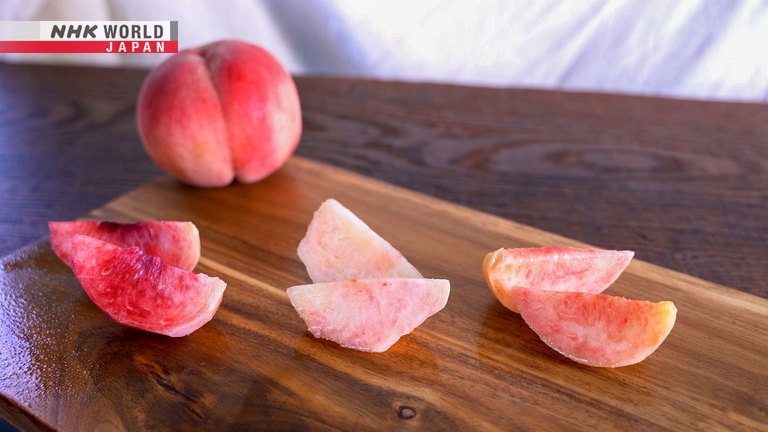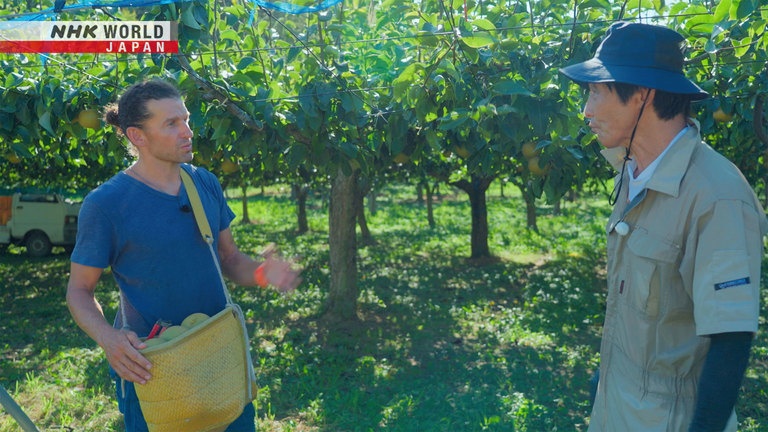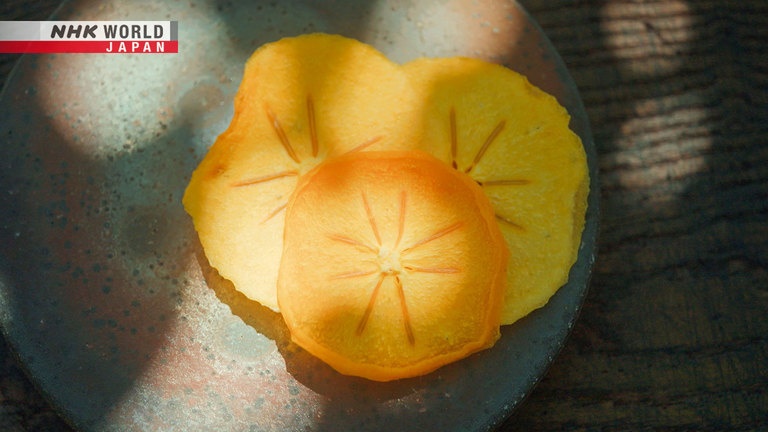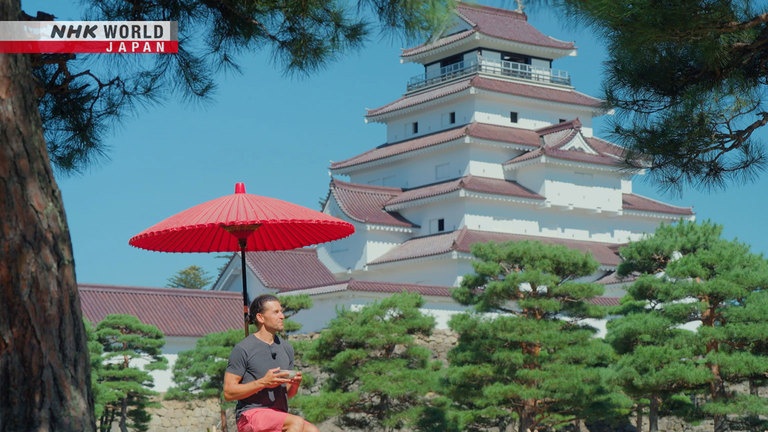FUKUSHIMA: FRUIT KINGDOM
Fukushima Prefecture has two mountain ranges and three differing climates, allowing a variety of fruits to grow. Areas facing the ocean have cool summers and warm winters—perfect for pears. In a basin sandwiched between eastern and western mountain ranges, daily temperature fluctuations produce large, sugar-packed peaches. Furthermore, inland areas with heavy snowfall offer some of the finest persimmons. Discover the charms of Japan's fruit kingdom—Fukushima. (Reporter: Michael Keida)




Transcript
Tokyo: this world-class metropolis is a veritable gourmet wonderland.
Discover the stories behind the ingredients that make this city so delicious - so "oishii."
Hi, I'm Michael Keida.
And this time I'm in the fruit kingdom, Fukushima.
Now you might not know this, but Fukushima is a leader in fruit production in Japan,
and the secret to why they make such good fruit is in these mountains behind me.
Let's go find out why.
Fukushima grows a lot of seasonal fruits all year round.
The prefecture has somewhat of a geographical advantage.
Two mountain ranges divide it into three distinct climate regions,
offering ideal conditions for different fruit types.
The Hamadori region faces the ocean to the east and has cool summers and warm winters.
Certain parts get lots of sea breeze, which is perfect for pears.
"Oishii."
In the Nakadori basin, located between the two mountain ranges, sugar-packed peaches are harvested in summer.
How about a full-course peach meal?
Discover fruit dishes unique to a massive production area.
The Aizu inland area gets heavy snowfall.
The persimmons grown there are so tasty, they were a go-to for shoguns of the past.
These trees are 100 years old.
These are?
Making the most of each regional climate, Fukushima has developed into a vast fruit kingdom.
Dig in to find out more!
Trails to Oishii Tokyo.
The Nakadori region is a basin that sits between the prefecture's two mountain ranges.
Here, the temperature varies greatly throughout the day.
Fruits produce nutrients during warm sunlight hours,
and store sugar at night when the temperature cools.
This makes the fruit nice and sweet.
Nakadori is mostly known for its peaches.
Quality producers are found all around the capital city of Fukushima.
Look all peaches on the trees over there.
Hello!
Hello!
- I'm Michael. Nice to meet you.
- Welcome! Likewise.
You're looking a little pink.
It's my uniform, not a fashion choice.
But it looks great!
This is Sato Seiichi.
He grows about 20 kinds of peaches over 10 hectares of land.
I'm getting a strong peach smell.
This variety is called akatsuki.
It's in peak season.
Akatsuki. Dawn?
Akatsuki is the most common variety in Japan.
Fukushima accounts for over half of the country's production volume.
They're big, juicy, and very sweet.
Does it originate in Fukushima?
Yes, it's been nurtured with care here.
Peaches were likely brought to Japan around 6,000 years ago.
But they were smaller, and used mainly for flower cultivation.
Peaches took off as a food in the late 19th century.
After local trial and error around Fukushima, the akatsuki peach became larger and richer in flavor.
More recently, crossbreeding has led to many new varieties.
They have a lovely pink color all around.
They receive light from top to bottom.
Straight sunlight from above,
and its reflection from the sheet below.
That's what the sheet's for?
Right, to improve color and flavor.
To ensure the peaches are fully exposed, surrounding leaves are carefully picked by hand.
It's a labor of love that nobody sees.
Once fully pink, they're ready to harvest.
How do you pick them?
By hand. No knives or scissors.
Twist it gently.
I got it.
Well done.
So beautiful.
Next, Michael learns how to peel them.
Cut straight into it like this.
When you hit the seed,
cut all the way around.
Then, twist left and right.
If you peel too much, flavor will be lost.
Peel it as thinly as possible.
- Fresh from the tree. Enjoy.
- Itadakimasu.
It's so good.
It's got a crunchy texture, and there's actually a little bit of a tart to it.
It's got a really fresh flavor and just a mild amount of sweetness.
- Nice and firm.
- Yeah, only when it's this fresh.
People think peaches are soft, because
that's how they are when they buy them.
But freshly-harvested ones are nice and firm.
And very juicy. Lots of juice comes out.
All peaches may look the same, but each type offers a unique flavor and texture.
After the akatsuki, the hakuho peach is the second-most produced in Japan.
It's soft enough to be peeled by hand, and it's very juicy.
It's so soft.
It has a texture almost like canned peaches.
They're just totally soft. It melts in your mouth.
But it's got the freshness of a just-now-picked peach.
So good.
Madoka peaches make a nice sound when they're peeled.
They're firm and crisp, like apples.
They also have low acidity.
Peach season is quite short.
Farmers manipulate pollination so that varieties can be harvested at different times.
That way, shipments can be made over a longer period of time.
Do you enjoy growing peaches?
I care for them like children,
so I take great pride in the result.
And I love seeing smiles on
faces when they're eaten.
Wonderful.
Tasty, sweet peaches born in the warm and sunny basin of Fukushima.
The city of Fukushima holds an annual event
where peaches that didn't meet shipping requirements are offered in several ways.
Over 100 peach products are available to try.
Wow, there's so many different foods in Fukushima that have a peach theme going on.
And a couple that I really had interest in is peach potato chips and also peach cola, peach ale...
I'm just gonna give them all a try and see what they have in store.
That's really interesting.
It's just got the saltiness of a regular potato chip, but it has this aroma that pokes through-of peach.
It's actually really good.
Japanese sweets, western sweets, even drinks...
This is only a small sample-there's a big, peachy world out there!
Here's what Michael wants most.
Peach ale-beer made with white peaches.
Cheers.
That's so good.
I was expecting it to be a little bit sweeter, but it's actually got a little bit of a tart flavor.
Almost like a cider, but smooth like an ale.
I can't believe there's so many ways that you can use "momo," peaches,
to make so many different types of snacks, foods, and drinks.
Who would have ever thought?
Michael's next stop is a Japanese inn with a unique menu.
Look at what they got here.
They've got peach juice, from a tap!
Apparently, in Japan, it's every child's dream to be able to drink juice out of a tap, so...
Perfect for a hot summer day.
After a quick refreshment, it's time for the real treat.
They offer a Japanese 8-course meal, and peaches are in every dish.
I used three varieties of peach today.
I see. How do you choose what to use?
I look at a peach's firmness and acidity,
and try different ways to accent sweetness.
I play around to create recipes
that suit each variety of peach.
For the appetizer, he used sweet and juicy akatsuki.
Sour madoka peaches are served with sashimi.
They accent the sweetness of the fish.
Itadakimasu.
That just keeps on changing.
There's this...each bite, the flavor goes from sweet to a little bit of saltiness,
a little bit of sourness, a little bit of umami, back to sweet again...
it just kind of keeps on dancing in my mouth.
Wow, that's so good.
For a tempura dish, he used firm odoroki peaches.
They have a similar texture to Japanese persimmons.
Wow, that is so good.
"Oishii."
It starts off with a little bit of that saltiness from the coating on the outside,
but as soon as you bit into it, there's this juicy sweetness that pops out.
But not overpowering like a dessert.
That's my first experience having tempura like that.
Which dish do you prefer?
Chirashi sushi is a fun one.
It's beautiful.
It's prepared like a salad,
with a peach dressing.
- Itadakimasu.
- Mix it up.
- There are peaches at the bottom.
- I see!
It's so good.
It's incredible, so many different textures, and the flavors, you know, some are a little bit sweeter than others,
and it just really goes so well with all the different flavors in the food.
It's just a flavor adventure.
I'm amazed.
Each dish offers different flavors.
I never could have imagined anything like it.
It's all very new, but not strange at all.
It's genius.
- It's fun to eat, right?
- Yes, very.
- That's what I'm aiming for.
- Nice.
Beautiful peaches have no boundaries.
At the Soma Nomaoi festival, hundreds of warriors race on horseback.
The event, dating back over 1,000 years, is said to have started as a samurai training program.
It's held in Hamadori, on the coast of Fukushima.
Pacific winds keep the area cool in summer and warm in winter.
The unique environment makes fruit from the district of Isobe especially sweet and tasty.
Wow, check out the view! You can see the ocean from here.
What are you harvesting?
Pears.
Wow. There's lots of them.
Summer is peak harvest season for pears.
It's said that pears have been eaten in Japan for about 2,000 years.
Techniques developed in the Edo period led to the cultivation of over 100 varieties.
The trees are short.
Taller than usual though.
Before harvest, the fruit get heavy
and the trellises hang lower.
A network of wires, or trellises, can be seen in the branches.
They support the pears during cultivation.
When the wires are hanging low, the pears are ready to harvest.
It's tough when you're tall like we are.
But it can't be helped.
The work has to be done.
What kind of pears are they?
They are kosui pears.
The name means happy water.
Kosui are the most widely produced in Japan.
They need lots of sunlight
to maintain sugar content.
In the shade, they don't turn out as well.
The ones in the sun are yellow.
Right, getting a sun tan gives
them a higher sugar content.
- How do you pick them?
- It's simple.
Hold it from the bottom and rotate it upwards.
Oh, that's all.
If we put it in the bucket like this,
the stem will damage other pears.
We need to cut it off with scissors.
After that, it goes in the bucket.
- Can I try?
- Go ahead.
Good.
Pretty easy.
Get that big one.
It'll be a tasty one.
Thick stem.
- They say thicker stems bear larger pears.
- I see.
This one's big too!
The field has around 650 pear trees.
Up to a metric ton of pears can be picked in one day.
Once picked, they're loaded onto a truck.
I think your roof is missing...
- Just an ordinary truck.
- I beg to differ.
This is better for driving around fields.
Nemoto modified the truck himself.
I see, you're just below the trellises.
You don't harvest while driving, do you?
No, I don't.
What's special about pears in this area?
We get the ocean breeze.
You saw the Pacific Ocean
on your way here, right?
Minerals from the breeze boost sugar content.
That's what makes our area, Isobe, stand out.
Pears harvested near the ocean
are 1 to 2 degrees sweeter.
The ocean breeze carries minerals to the pears, boosting sweetness.
For that reason, pear lovers from across the country come to buy them.
- Can I eat it with the peel?
- Of course.
"Itadakimasu."
- "Oishii."
- I can tell by your face.
It's so juicy. Excuse me.
Juices are starting to run down my arm.
Crispy, light sweetness, almost a honey type of flavor to it.
Nemoto recently introduced a cultivation method that reduces overall harvest time significantly.
Trees are linked together to enhance trunk growth.
This also simplifies workflow and improves efficiency.
I want to make it easier for
younger people to get involved.
I hope my son will take over for me.
At the same time, I want to
promote our area's amazing pears.
Wonderful. Good luck.
Sweet pears nurtured by the ocean, and future aspirations.
Right now, I'm in Aizu, the western-most part of the prefecture.
And apparently in this area there's a tasty fruit that was even enjoyed by the shogun.
I'm gonna go find out.
This is Aizu's iconic Tsurugajo Castle.
Like in Nakadori, temperatures in Aizu fluctuate greatly.
It's also one of Japan's snowiest areas, with nearly half of the annual precipitation being snowfall.
These conditions make tasty fruit that even shoguns of the past couldn't resist.
Hello.
What are you doing now?
Strong sun this year burned some fruit.
I'm taking out ones I can't sell.
Persimmons? What variety?
Mishirazu.
Mishirazu persimmons have been cultivated here for ages.
When presented to the shogun, he apparently claimed he'd never tasted anything like it!
This variety dates back around 500 years.
This is their current size.
When the November harvest comes, they'll be
12 cm in diameter. About twice as large.
Daily temperature gaps allow the fruit to store more sugar.
But heavy snowfall presents certain obstacles.
The longer we wait to harvest,
the sweeter they will be.
But fall is short in Aizu,
and ice forms in mid-November.
If they freeze, we can't sell them.
We wait as long as we can,
but it's a tough balancing act.
The persimmons are harvested all at once before it's too late.
He gets a lot of help from this elevated platform.
Safer and faster than using a ladder, it gets farmers to every tree with ease.
Yamauchi's fields cover around 50 hectares.
They've been here for generations.
He can harvest up to 3 metric tons in one day, or some 50 metric tons in the 3 weeks before the ice sets in.
Mishirazu persimmons grow large in the summer sun, and ripen in the cold.
Nowadays, the tasty persimmons are offered to Japan's royal family.
Tradition and quality are maintained with pride.
How should it taste when it's ready?
It melts in your mouth.
But it's not soft. It begins with
a firm texture that soon melts away.
That's what the shoguns loved.
I guess so.
Michael was too early to try any.
Instead, he gets persimmons from last year's harvest that have been dried.
"Itadakimasu."
"Oishii."
Light sweetness.
It comes out the more you chew.
- I'll be back in fall.
- I'll be here.
The four seasons of Fukushima continue to offer tasty gifts.
In Fukushima, every ingredient has its own story.